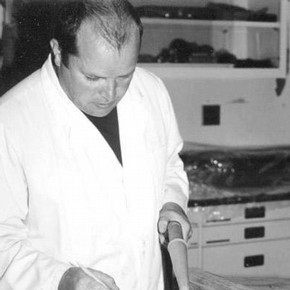Conservation Journal
January 1997 Issue 22
Summer Placement at the Canadian Conservation Institute
The Canadian Conservation Institute (CCI), located in Ottawa , is a part of the Department of Canadian Heritage. Its mandate is to 'Promote the proper care and preservation of Canada’s moveable cultural heritage, and to advance the practice, science and technology of conservation'.
My internship at CCI was for 10 weeks, from June to August 1996, where I worked in the Ethnology Studio under the direction of Senior Conservator, Bob Barclay. The purpose of this placement was to learn something of professional working practices at CCI, to undertake challenging project work and to visit other conservation facilities in Ottawa .
My introduction to CCI consisted of an informal tour of the facilities and studios where I met members of staff and other interns. This afforded an opportunity to see some of the conservation work being undertaken so I was better able to appreciate subsequent, lengthier departmental visits. I shared the Ethnology Lab with five conservators and one other intern from the MA programme at Queen's University, Ontario. I was allowed full use of very extensive facilities and assistance from other departments was offered when needed.
My main project work concerned the treatment of a church organ. This was an early 19th century instrument and was kept in the Sharon Temple, former home of the Children of Light sect and now a historic house. The first task was to travel to the temple and load the organ for transport to CCI. The instrument had been previously partially disassembled so I could see, even at that early stage, that this project might not be entirely straightforward.
Conservation treatment began with an inspection of the various parts of the instrument followed by a detailed report. The curator at Sharon Temple granted permission and interventive treatment began. The early inspection revealed that the instrument had been heavily infested with mice. This could have caused problems as certain types of mouse droppings are highly poisonous. Analysis of samples by the Environment & Deterioration Research Department at CCI revealed that the droppings were no longer infectious so treatment could continue. However, the damage caused by the mice was so extensive that there was no possibility of the instrument ever being put into playing condition.
Laboratory work was interspersed with a series of visits to other laboratories within CCI and at other institutions in the Ottawa area. A visit to the Museum of Science and Technology raised questions about the storage of artefacts of a radioactive nature. The facilities at the Parks Canada laboratories were completely new and incorporated many built-in features, including rear of bench slot fume extraction and plumbed-in vacuum cleaners. I also had the chance to visit the conservation facilities at the Canadian Museum of Civilisation and the Canadian War Museum.
The treatment of the organ took 175 hours. The majority of the work was surface cleaning using a variety of mechanical and solvent methods. A number of repairs were needed to secure the structure of the instrument. Each replacement part was marked discreetly, CCI 1996, so there would be no doubt as to its provenance in the future and all parts were labelled so reassembly appeared to be slickly efficient. The instrument was returned to Sharon Temple the day prior to my departure.
Working at CCI proved to be as fulfilling as I had hoped. I was constantly challenged on levels and methods of treatment and intervention and am grateful for the unconditional support I received from all members of the CCI staff. I would particularly like to thank: Tom Stone, Bob Barclay, Janet Mason, George Prytulak, Carole Dignard and Deborah Stewart.
January 1997 Issue 22
- Editorial
- Weighing up silver objects: evaluating past and future conservation methods
- Reflections on Silver
- Investigations into the Use of Laponite as a Poulticing Material in Ceramics Conservation
- Nappies at the National Museum of Childhood
- Mounts for the Display of Books
- The Archive of Heal & Son Limited
- Slides and Frisbees - Determining Dust Deposition Rates
- Summer Placement at the Canadian Conservation Institute
- Summer Placement at the Central Research Laboratory for Objects of Art and Science, Amsterdam
- Printer Friendly Version
